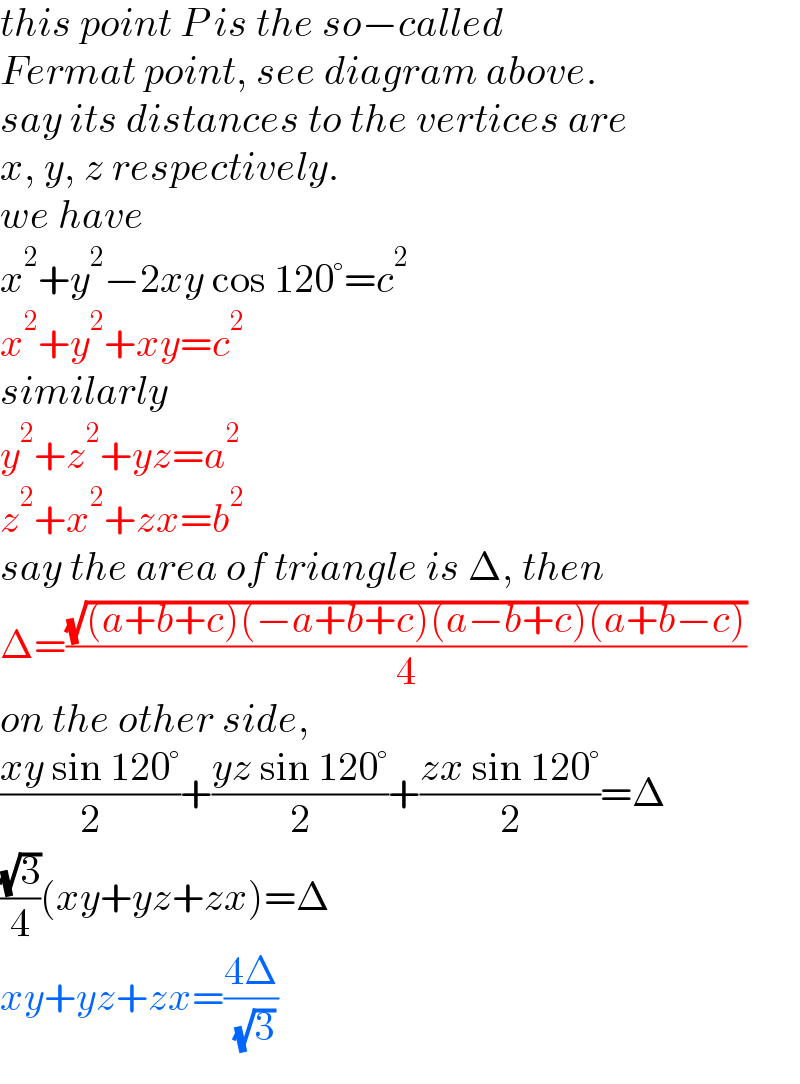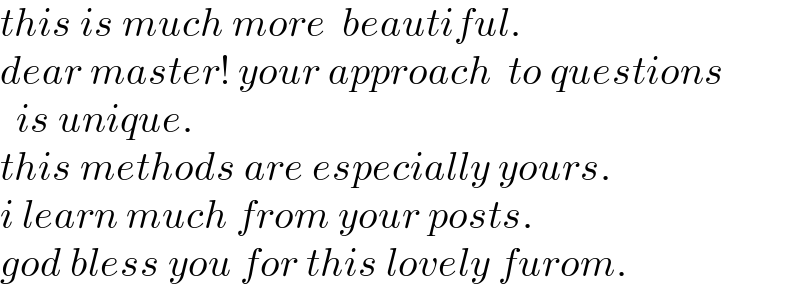Question Number 164174 by mr W last updated on 15/Jan/22

Commented by mr W last updated on 15/Jan/22

$${find}\:{the}\:{position}\:{of}\:{point}\:{P}\:{in}\:{a} \\ $$$${given}\:{triangle}\:{such}\:{that}\:{the}\:{sum} \\ $$$${of}\:{its}\:{distances}\:{to}\:{the}\:{vertices}\:{is} \\ $$$${minimum}.\:{find}\:{the}\:{corresponding} \\ $$$${distances}\:{to}\:{the}\:{vertices}. \\ $$
Answered by mr W last updated on 15/Jan/22

Commented by mr W last updated on 15/Jan/22

Commented by mr W last updated on 15/Jan/22

$${this}\:{point}\:{P}\:{is}\:{the}\:{so}−{called}\: \\ $$$${Fermat}\:{point},\:{see}\:{diagram}\:{above}. \\ $$$${say}\:{its}\:{distances}\:{to}\:{the}\:{vertices}\:{are} \\ $$$${x},\:{y},\:{z}\:{respectively}. \\ $$$${we}\:{have} \\ $$$${x}^{\mathrm{2}} +{y}^{\mathrm{2}} −\mathrm{2}{xy}\:\mathrm{cos}\:\mathrm{120}°={c}^{\mathrm{2}} \\ $$$${x}^{\mathrm{2}} +{y}^{\mathrm{2}} +{xy}={c}^{\mathrm{2}} \\ $$$${similarly} \\ $$$${y}^{\mathrm{2}} +{z}^{\mathrm{2}} +{yz}={a}^{\mathrm{2}} \\ $$$${z}^{\mathrm{2}} +{x}^{\mathrm{2}} +{zx}={b}^{\mathrm{2}} \\ $$$${say}\:{the}\:{area}\:{of}\:{triangle}\:{is}\:\Delta,\:{then} \\ $$$$\Delta=\frac{\sqrt{\left({a}+{b}+{c}\right)\left(−{a}+{b}+{c}\right)\left({a}−{b}+{c}\right)\left({a}+{b}−{c}\right)}}{\mathrm{4}} \\ $$$${on}\:{the}\:{other}\:{side}, \\ $$$$\frac{{xy}\:\mathrm{sin}\:\mathrm{120}°}{\mathrm{2}}+\frac{{yz}\:\mathrm{sin}\:\mathrm{120}°}{\mathrm{2}}+\frac{{zx}\:\mathrm{sin}\:\mathrm{120}°}{\mathrm{2}}=\Delta \\ $$$$\frac{\sqrt{\mathrm{3}}}{\mathrm{4}}\left({xy}+{yz}+{zx}\right)=\Delta \\ $$$${xy}+{yz}+{zx}=\frac{\mathrm{4}\Delta}{\:\sqrt{\mathrm{3}}} \\ $$
Commented by mr W last updated on 16/Jan/22
![BA′=(2/3)×(((√3)a)/2)=(((√3)a)/3) BC′=(((√3)c)/3) ∠A′BC′=∠B+60° C′A′^2 =((((√3)a)/3))^2 +((((√3)c)/3))^2 −2×(((√3)a)/3)×(((√3)c)/3) cos (∠B+60°) C′A′^2 =((a^2 +c^2 −ac(cos ∠B−(√3) sin ∠B) )/3) C′A′^2 =(1/3)[a^2 +c^2 −ac(((a^2 +c^2 −b^2 )/(2ac))−((2(√3)Δ)/(ac)))] C′A′^2 =((a^2 +b^2 +c^2 +4(√3)Δ)/6) C′A′=A′B′=B′C′=(√((a^2 +b^2 +c^2 +4(√3)Δ)/6))=d, say (this is the side length of Napoleon triangle A′B′C′) ((yd)/2)=(((√3)a)/3)×(((√3)c)/3)×sin (∠B+60°)=area [PA′BC′] y=((ac)/(3d))×(sin ∠B+(√3) cos ∠B) y=((ac)/(3d))×(((2Δ)/(ac))+(√3) ×((a^2 +c^2 −b^2 )/(2ac))) y=((4Δ+(√3)(a^2 −b^2 +c^2 ))/(6d)) y=((4(√6)Δ+3(√2)(a^2 −b^2 +c^2 ))/( 6(√(a^2 +b^2 +c^2 +4(√3)Δ)))) similarly x=((4(√6)Δ+3(√2)(−a^2 +b^2 +c^2 ))/( 6(√(a^2 +b^2 +c^2 +4(√3)Δ)))) z=((4(√6)Δ+3(√2)(a^2 +b^2 −c^2 ))/(6(√(a^2 +b^2 +c^2 +4(√3)Δ)))) x+y+z=(√((a^2 +b^2 +c^2 +4(√3)Δ)/2)) ■](https://www.tinkutara.com/question/Q164223.png)
$${BA}'=\frac{\mathrm{2}}{\mathrm{3}}×\frac{\sqrt{\mathrm{3}}{a}}{\mathrm{2}}=\frac{\sqrt{\mathrm{3}}{a}}{\mathrm{3}} \\ $$$${BC}'=\frac{\sqrt{\mathrm{3}}{c}}{\mathrm{3}} \\ $$$$\angle{A}'{BC}'=\angle{B}+\mathrm{60}° \\ $$$${C}'{A}'^{\mathrm{2}} =\left(\frac{\sqrt{\mathrm{3}}{a}}{\mathrm{3}}\right)^{\mathrm{2}} +\left(\frac{\sqrt{\mathrm{3}}{c}}{\mathrm{3}}\right)^{\mathrm{2}} −\mathrm{2}×\frac{\sqrt{\mathrm{3}}{a}}{\mathrm{3}}×\frac{\sqrt{\mathrm{3}}{c}}{\mathrm{3}}\:\mathrm{cos}\:\left(\angle{B}+\mathrm{60}°\right) \\ $$$${C}'{A}'^{\mathrm{2}} =\frac{{a}^{\mathrm{2}} +{c}^{\mathrm{2}} −{ac}\left(\mathrm{cos}\:\angle{B}−\sqrt{\mathrm{3}}\:\mathrm{sin}\:\angle{B}\right)\:}{\mathrm{3}} \\ $$$${C}'{A}'^{\mathrm{2}} =\frac{\mathrm{1}}{\mathrm{3}}\left[{a}^{\mathrm{2}} +{c}^{\mathrm{2}} −{ac}\left(\frac{{a}^{\mathrm{2}} +{c}^{\mathrm{2}} −{b}^{\mathrm{2}} }{\mathrm{2}{ac}}−\frac{\mathrm{2}\sqrt{\mathrm{3}}\Delta}{{ac}}\right)\right] \\ $$$${C}'{A}'^{\mathrm{2}} =\frac{{a}^{\mathrm{2}} +{b}^{\mathrm{2}} +{c}^{\mathrm{2}} +\mathrm{4}\sqrt{\mathrm{3}}\Delta}{\mathrm{6}} \\ $$$${C}'{A}'={A}'{B}'={B}'{C}'=\sqrt{\frac{{a}^{\mathrm{2}} +{b}^{\mathrm{2}} +{c}^{\mathrm{2}} +\mathrm{4}\sqrt{\mathrm{3}}\Delta}{\mathrm{6}}}={d},\:{say} \\ $$$$\left({this}\:{is}\:{the}\:{side}\:{length}\:{of}\:{Napoleon}\right. \\ $$$$\left.{triangle}\:{A}'{B}'{C}'\right) \\ $$$$ \\ $$$$\frac{{yd}}{\mathrm{2}}=\frac{\sqrt{\mathrm{3}}{a}}{\mathrm{3}}×\frac{\sqrt{\mathrm{3}}{c}}{\mathrm{3}}×\mathrm{sin}\:\left(\angle{B}+\mathrm{60}°\right)={area}\:\left[{PA}'{BC}'\right] \\ $$$${y}=\frac{{ac}}{\mathrm{3}{d}}×\left(\mathrm{sin}\:\angle{B}+\sqrt{\mathrm{3}}\:\mathrm{cos}\:\angle{B}\right) \\ $$$${y}=\frac{{ac}}{\mathrm{3}{d}}×\left(\frac{\mathrm{2}\Delta}{{ac}}+\sqrt{\mathrm{3}}\:×\frac{{a}^{\mathrm{2}} +{c}^{\mathrm{2}} −{b}^{\mathrm{2}} }{\mathrm{2}{ac}}\right) \\ $$$${y}=\frac{\mathrm{4}\Delta+\sqrt{\mathrm{3}}\left({a}^{\mathrm{2}} −{b}^{\mathrm{2}} +{c}^{\mathrm{2}} \right)}{\mathrm{6}{d}} \\ $$$${y}=\frac{\mathrm{4}\sqrt{\mathrm{6}}\Delta+\mathrm{3}\sqrt{\mathrm{2}}\left({a}^{\mathrm{2}} −{b}^{\mathrm{2}} +{c}^{\mathrm{2}} \right)}{\:\mathrm{6}\sqrt{{a}^{\mathrm{2}} +{b}^{\mathrm{2}} +{c}^{\mathrm{2}} +\mathrm{4}\sqrt{\mathrm{3}}\Delta}} \\ $$$${similarly} \\ $$$${x}=\frac{\mathrm{4}\sqrt{\mathrm{6}}\Delta+\mathrm{3}\sqrt{\mathrm{2}}\left(−{a}^{\mathrm{2}} +{b}^{\mathrm{2}} +{c}^{\mathrm{2}} \right)}{\:\mathrm{6}\sqrt{{a}^{\mathrm{2}} +{b}^{\mathrm{2}} +{c}^{\mathrm{2}} +\mathrm{4}\sqrt{\mathrm{3}}\Delta}} \\ $$$${z}=\frac{\mathrm{4}\sqrt{\mathrm{6}}\Delta+\mathrm{3}\sqrt{\mathrm{2}}\left({a}^{\mathrm{2}} +{b}^{\mathrm{2}} −{c}^{\mathrm{2}} \right)}{\mathrm{6}\sqrt{{a}^{\mathrm{2}} +{b}^{\mathrm{2}} +{c}^{\mathrm{2}} +\mathrm{4}\sqrt{\mathrm{3}}\Delta}} \\ $$$$ \\ $$$${x}+{y}+{z}=\sqrt{\frac{{a}^{\mathrm{2}} +{b}^{\mathrm{2}} +{c}^{\mathrm{2}} +\mathrm{4}\sqrt{\mathrm{3}}\Delta}{\mathrm{2}}} \\ $$$$\blacksquare \\ $$
Commented by behi834171 last updated on 15/Jan/22
![very nice solution,dear master.thanks a lot. a=b=c⇒Δ=a^2 .((√3)/4) 4(√3)Δ+b^2 +3c^2 −a^2 =4(√3)×a^2 .((√3)/4)+3a^2 =6a^2 4(√3)Δ+a^2 +b^2 +c^2 =4(√3)×a^2 .((√3)/4)+3a^2 =6a^2 ⇒y=x=z=(√(((4a^2 )/3)−a^2 ))=a.((√3)/3) .■ [also see q≠14157]](https://www.tinkutara.com/question/Q164232.png)
$${very}\:{nice}\:{solution},{dear}\:{master}.{thanks}\:{a}\:{lot}. \\ $$$${a}={b}={c}\Rightarrow\Delta={a}^{\mathrm{2}} .\frac{\sqrt{\mathrm{3}}}{\mathrm{4}} \\ $$$$\mathrm{4}\sqrt{\mathrm{3}}\Delta+{b}^{\mathrm{2}} +\mathrm{3}{c}^{\mathrm{2}} −{a}^{\mathrm{2}} =\mathrm{4}\sqrt{\mathrm{3}}×{a}^{\mathrm{2}} .\frac{\sqrt{\mathrm{3}}}{\mathrm{4}}+\mathrm{3}{a}^{\mathrm{2}} =\mathrm{6}{a}^{\mathrm{2}} \\ $$$$\mathrm{4}\sqrt{\mathrm{3}}\Delta+{a}^{\mathrm{2}} +{b}^{\mathrm{2}} +{c}^{\mathrm{2}} =\mathrm{4}\sqrt{\mathrm{3}}×{a}^{\mathrm{2}} .\frac{\sqrt{\mathrm{3}}}{\mathrm{4}}+\mathrm{3}{a}^{\mathrm{2}} =\mathrm{6}{a}^{\mathrm{2}} \\ $$$$\Rightarrow\boldsymbol{{y}}={x}={z}=\sqrt{\frac{\mathrm{4}\boldsymbol{{a}}^{\mathrm{2}} }{\mathrm{3}}−\boldsymbol{{a}}^{\mathrm{2}} }=\boldsymbol{{a}}.\frac{\sqrt{\mathrm{3}}}{\mathrm{3}}\:\:.\blacksquare \\ $$$$\left[{also}\:\:{see}\:\:{q}\neq\mathrm{14157}\right] \\ $$
Commented by mr W last updated on 15/Jan/22

$${thanks}\:{alot}\:{sir}! \\ $$$${i}'{ve}\:{forgot}\:{that}\:{old}\:{post}. \\ $$$${now}\:{i}\:{have}\:{found}\:{a}\:{better}\:{formula}\:{in} \\ $$$${symmetric}\:{form}\:{for}\:{x},\:{y},\:{z},\:{see}\:{above}, \\ $$$${please}\:{review}! \\ $$
Commented by Tawa11 last updated on 15/Jan/22

$$\mathrm{Great}\:\mathrm{sir}. \\ $$
Commented by Tawa11 last updated on 15/Jan/22

$$\mathrm{Thanks}\:\mathrm{for}\:\mathrm{your}\:\mathrm{time}. \\ $$
Commented by behi834171 last updated on 15/Jan/22

$${this}\:{is}\:{much}\:{more}\:\:{beautiful}. \\ $$$${dear}\:{master}!\:{your}\:{approach}\:\:{to}\:{questions} \\ $$$$\:\:{is}\:{unique}. \\ $$$${this}\:{methods}\:{are}\:{especially}\:{yours}. \\ $$$${i}\:{learn}\:{much}\:{from}\:{your}\:{posts}. \\ $$$${god}\:{bless}\:{you}\:{for}\:{this}\:{lovely}\:{furom}. \\ $$
Commented by mr W last updated on 15/Jan/22

$${thanks}\:{for}\:{reviewing}\:{my}\:{posts}\:{sir}! \\ $$
